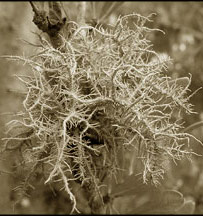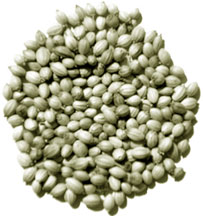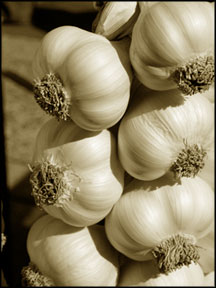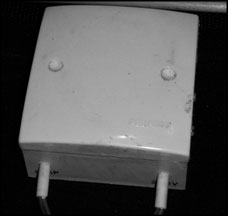sci-tech
Strengthening the battle against cancer
Unique finding from Sri Lankan Scientists:
Dhaneshi YATAWARA
Healing cancer or even controlling it, is considered to be a miracle.
Hence, new medicines, compounds, methods etc flow into the Medical
science field almost every day. To the world, with its present levels of
pollution, dealing with cancer have become vital.


Lichen - Usnea species |

Asparagus |

Nigella sativa seeds |

Coriander |
| |
Sri Lankan science field shows no exception. Sharpened with many
trial and errors, several local scientists have revealed many important
findings to strengthen the fight against cancer. The revelations are
unique and definitely with extended support on to these scientists these
novel concepts could stand significant in the international science
arena. In one research, funded by National Science Foundation of Sri
Lanka, a group of scientists found anti-cancer compounds in lichens of
the Usnea species. This research group of the Peradeniya University,
headed by Professor Veranja Karunaratne, discovered the most potent and
promising anti cancer compound to be discovered from any land or marine
source of the country in these specific lichens found in Ambewela.
The research work of this project was undertaken to explore the
potential of Sri Lankan lichens, a hitherto unexplored source of new
bio-active compounds.
Lichens are mutually benefiting associations of a fungus with another
plant, usually a green algae or a cynobacterium that can produce food
for the lichen from sunlight. In the natural environment, lichen
provides the algae with water and minerals that the fungus absorbs from
its substrate. As for the algae, it uses the minerals and water to make
food for the fungus and itself.
The researchers collected the bio-active compound of four lichens,
separated and purified. The group was able to extract three compounds
from the chemical extract of Usnea type lichen collected from Ambewela.
Two of these compounds, named Ambewelamide A and Ambewelamide B, were
found to be new members of a family of highly modified chemicals and are
the first examples of this family of compounds isolated from a lichen.
Researchers found that Ambewelamide A showed anti-cancer properties
along with anti-fungal activity, more active than certain commercial
preparations and mosquito larvicidal (mosquito larvae killing) ability.
The National Science Foundation stated that a Canadian patent
application was filed based on the promising bio-activity of this
compound.
The third compound separated from this lichen namely Usnic Acid, have
shown anti-termite activity in addition to antifungal and mosquito
larvicidal ability. Another highlight of this research program was the
organisation of the first ever National Work shop on Sri Lankan Lichens,
in May 1999.
Ayurvedic miracle
In two other researches, funded by the National Science Foundation,
proved anti-carcinogenic properties of ayurvedic decoctions, especially
for liver cancer. Liver cancer is rated as the eighth leading cause of
cancer deaths worldwide. According to medical experts, B and C types of
Viral Hepatitis infection or cirrhosis associated with alcohol
consumption are the two major causes of liver cancer.
In a research jointly carried by the Bio-chemistry departments of
Universities of Sri Jayawardanepura and Kelaniya, scientifically tested
anti-cancer properties of some herbal extracts used in traditional
Ayurvedic medicine. Dr. Nalini Wickramasinghe, formerly of the Faculty
of Medical Sciences of the Sri Jayawardanepura University and Professor
Ira Thabrew formerly of the Department of Bio-chemistry and clinical
chemistry, Medical Faculty of the University of Kelaniya jointly carried
the research.
In ayurvedic medicine, several plant based treatments are being
recommended for cancer. But, none have been subjected to a proper
scientific testing so far.
In this typical research, a decoction that contained black cumin seed
(Nigella sativa or kalu duru), root of Indian sarsaparilla or iramusu in
Sinhala and 'arakkan' in Tamil (Hemidesmus indicus) and rhizome of
Chinese sarsaparilla (Smilax glabra) was prepared according to the
methods recommended by traditional ayurvedic medical practitioners to
cancer patients.
This decoction was tested for protective effects against chemically
induced cancer of the liver in laboratory rats. A normal medicinal dose
and a higher dose of this brew were tested on cancer induced rats.
Researchers found that though the overall result indicated that the
anti-cancer effects of the medicinal dose were good, it was better with
a higher dose.
Tests also confirmed that there were no toxic effects of the
decoction on the liver, kidneys, lung, heart, stomach and gut. Blood
components showed no affect by three months treatment of this decoction.
In addition, no unfavourable effects were seen on the fertility and
breeding of both male and female rats. The three month long treatment of
this decoction showed no change in food intake, average body weight gain
and general behaviour of the animal. It also showed even given in 40
time stronger dose than the normal it did not cause any deaths in rats.
In another study done by Professor Chitra Pathirana of Bio-chemistry
department of the Medical Faculty of the University of Ruhuna showed
liver healing properties of five common herbal plants used in
traditional medicine in Sri Lanka.
Studies were carried out on mice to scientifically evaluate the
claims of traditional medical properties of five herbal plants believed
to have anti-toxic effects on the liver. Two liver toxins were selected
for the study - i.e. Carbon Tetrachloride and Paracetamol. An over dose
of Paracetamol can damage the liver. Damage caused by Carbon
Tetrachloride was similar to that of viral hepatitis.
The plants were Neeramilliya (Asparagus falcatus) Heen Mudumahana (Epaltes
divaricata), coriander (Corriandrum sativum) and sevendara (Vertiveria
sp.). Extracts of these plants were fed in to laboratory mice both
before inducing liver injuries and after using the two liver toxins.
Liver enzymes and pathological changes were studied to find out the
effects. The overall result of this study showed that all five plant
extracts have some ability to protect the liver against injuries caused
by over dose of Paracetamol and Carbon Tetrachloride. The level of
protection shown, varied among the different plant extracts.
The importance is that though there are few drugs used in treating
liver diseases they are costly and can often be not very effective. In
addition they have side effects. Therefore, the search for safe,
inexpensive, alternative liver protective drugs is a major requirement.
It was claimed that traditional medicinal herbs have remarkable ability
to restore liver health.
Reducing risk of liver cancer
 Garlic has been used both for cooking and medicinal purposes in many
cultures for thousands of years, dating as far back as the time that the
Egyptian pyramids were built. It is well known that garlic contains
substances which are important for human health. Garlic has been used both for cooking and medicinal purposes in many
cultures for thousands of years, dating as far back as the time that the
Egyptian pyramids were built. It is well known that garlic contains
substances which are important for human health.
Among many other claims garlic is thought to help prevent heart
diseases, high blood pressure, and cancer as well. Since including
garlic in the diet reduces blood cholesterol levels in normal and high
cholesterol individuals, several commercial forms of garlic such as
garlic tablets are used for the treatment of high blood cholesterol.
A study, funded by a grant from the National Science Foundation, was
undertaken by a team of scientists from the Department of Biochemistry,
University of Sri Jayewardenepura to find out whether treatment with
medicinal doses of garlic reduces liver cancer caused by chemicals in
normal rats, and in rats with high cholesterol levels.
The study looked into the claims of anti-cancer properties of garlic
using laboratory rats. A daily treatment of a medicinal dose of
oven-dried, powdered garlic was given to normal laboratory rats for two
weeks.
These rats were then injected with a chemical (DEN) to induce liver
cancer in them. Garlic treatment was continued for eight more weeks.
While another group of rats were given only DEN (no garlic), a third
group of rats were given only garlic (no DEN). The livers of all these
rats were examined for the growth of cancer. Those given DEN had
developed cancer of the liver but the DEN plus garlic treated rats
showed a remarkable lowering of the cancer formation in their livers.
This study proved that garlic reduced the risk of liver cancer in normal
rats.
A similar study was carried out on three groups of rats with high
cholesterol. This study verified again the preventive properties of
garlic on liver cancer. It further showed that the risk of development
of liver cancer was higher in high cholesterol rats than in normal rats.
Therefore, rats with high cholesterol levels were more prone to liver
cancer.
This study, substantiates that garlic can reduce the risk of liver
cancer and thus inclusion of garlic in our diet may be important for
cancer prevention.
Gliricidia, the multi-purpose alternative crop
Gliricidia species or better known as wetamara was identified as a
multi-faceted plant ideal for the tropical climate of Sri Lanka. Hence,
Gliricidia plantations were started to be used as an inter-crop with
coconut, tea, and different short-term cash crops. The use of Gliricidia
foliage as cattle fodder and organic nitrogenous fertiliser became very
popular in the agriculture sector.
|

Gliricidia tree |
The technology for using Gliricidia as fuel, fodder and fertiliser
crop has reached commercial scales in Sri Lanka.
Thus, realising the national benefits and its potential in Sri Lanka
the Government declared Gliricidia as the fourth plantation crop in the
country.
Recognising the importance of this lush green tree, a team of
scientists conducted a research program to determine the maximum that
could be exploited from the gliricidia species. The former Chancellor of
Moratuwa University, Vidya Jothi Dr. Ray Wijewardene, Director of
Alternative Energy Division of the Ministry of Science and Technology,
P.G. Joseph, President of the Bio Energy Association of Sri Lanka and
the Head of the Agronomy division of Coconut Research Institute Engr.
Parakrama Jayasinghe and the Chairman of the Coconut Cultivation Board
Dr. H. A. J. Gunathilake were the members of this research team.
Realising the need to develop indigenous resources in meeting the
country's energy needs, a research program was conducted by them to
determine the optimum parameters for Short Term Rotation Coppice (SRC)
energy plantation suitable for the degraded marginal lands in Sri Lanka.
|

Gliricidia flowers |
It has been identified that these SRC energy plantations were the
most suitable for the degraded marginal lands in the country. The
National Science Foundation presented a special award to this unique
research at the 2008 National Science and Technology Awards ceremony for
the contribution it made to the development of eco-materials/eco
friendly processes for industries. Researchers conducted experiments
using Gliricidia sepium trees at twelve different locations in the
country.
The optimum results were obtained from these trees planted at a
spacing of 1 metre x 1 metre and harvest was collected at six monthly
intervals. The researchers point out that by extending the Gliricidia
plantation to underutilised lands, the country's dependence on imported
fertilizer could be largely reduced.
In addition, our dairy industry could also be improved to meet our
national needs of milk and other dairy products. At present 75,000
tonnes of Gliricidia foliage per annum is being used as fodder as well
as fertilizer replacing 1500 tonnes of urea.
According to the researchers, at present, 10 off-grid electricity
generating projects with a total capacity of 130kW have been
established. Converting Gliricidia branch wood into producing
electricity or industrial heat was another successful invention. Hence,
15 industrial institutions have initiated energy producing projects by
using Gliricidia, instead of petroleum fuels.
According to the statistics its can save 18,000 tonnes of oil per
annum. This shows that a large proportion of grid and off-grid
electricity could be generated with indigenous fuel. The country could
eventually generate all the heat, energy requirements, etc., reducing
the need to import petroleum fuels.
(DY)
New devices to halt electricity wastage
UoM, NSF in joint effort:
|

Street lamp controller attached to a lamp post
|

Street lamp controller |

Ceiling fan controller |
The demand for energy in Sri Lanka has increased steeply over the
years. The total capacity of the country's electricity generation system
is rising each year at an approximate rate of 8%. This is expected to
grow at around 10% annually during the next decade mainly due to energy
wastage in the industrial, commercial and domestic sectors.
Reducing energy wastage is the main force behind a sustainable
electricity supply. A research team headed by Professor K. K. W. Perera
of the University of Moratuwa, funded by a grant from the National
Science Foundation, has developed three electronic devices that could
help save electricity.
Switching-on-and off of street lamps in most places in Sri Lanka is
done manually and it is quite often possible to see street lamps not
switched off even at mid day. This project has developed a low cost
electronic controller for automatically switching on and off of street
lamps. The principle, although widely applicable to street lighting can
also be used at home.
According to the researchers these automatic controllers can save
about an hour's electricity everyday by promptly switching off
unnecessary lights. The device needs no additional wiring. Being
completely solid state it has no mechanical components. The device
consumes very little energy and is highly reliable and requires hardly
any maintenance.
The second device is a timer for ceiling fans. Although timers are
commonly found in many industrial and domestic equipment, timers have
not been incorporated into a ceiling fan regulator. The researchers have
incorporated an Auto Timer Controller in a ceiling fan regulator. The
timer can be set at the time of going to sleep so that it will switch
off the fan at a preset time. In addition to saving energy it would
avoid inconvenience of having to get up to switch off the fan. The
device can replace the normal fan speed regulator. No additional wiring
is required. It can also be useful in offices where fans could be
switched off at the end of work.
The third device is an Alarm to indicate unnecessary use of
electricity with an optional tripping facility. This device sets off an
alarm to warn the user when excessive lamps or equipment are switched
on. The level of current at which the alarm should go off can be pre-set
based on the requirement of the household.
Thus, the user could be reminded to switch off some lights or other
devices and reduce his electricity bill. Such a device would also be
invaluable to save electricity in an office or any other industrial
site.
'Courtesy: National Science Foundation of Sri Lanka
Straw fertilizer boosts rice yields
For more than four decades, high yielding rice varieties were widely
grown with the use of chemical fertilizer in all rice cropping systems
of Sri Lanka. However, yield stagnation of rice was recorded in many
parts of the island in the early 80's, partly due to the decreased
fertility of rice soils.
It has been shown that adding rice straw at a rate of 4 tons per
hectare could provide the total potassium requirement and 30% of the
nitrogen requirement of the rice crop. But, recycling of rice straw is
not practices by many farmers mainly due to high labour costs involved
in transport straw to the field and the difficulty in harrowing and
ploughing the field in the presence of fresh straw.
Under natural conditions, fresh straw should undergo decomposition
for a period of about a month to become brittle. The slow decomposition
of rice straw is due to its high lignin and cellulose contents. The best
option to overcome this situation is to have the straw decompose
quickly. Only a few types of bacteria and fungi can decompose cellulose
and lignin in rice straw. Therefore, speeding up of the decomposition
process of rice straw by introducing such organisms would help overcome
difficulties arising in land preparation for paddy cultivation.
Microbiologists from the Faculty of Agriculture, University of
Peradeniya have isolated indigenous soil bacteria and fungi that can
accelerate the decomposition of rice straw in wetland rice fields.
Inoculant mixtures have been formulated with several bacteria and fungi.
These inoculants can be recommended for fresh rice straw from new
improved varieties used in wetland rice fields.
The mixed inoculants of bacteria and fungi isolated by the
researchers decompose straw rapidly with a weight reduction of up to 50%
in 20 days.
The decomposed material was also found to be high in nitrogen.
Incorporation of composted material in rice fields increased plant
growth, number of tillers and yield under field conditions. Since these
inoculants performed equally well, the field tests conducted at Kegalle
in the absence of chemical fertilizer, and at Peradeniya in the presence
of chemical fertilizer they could be recommended for both production
systems.
(Research funded by Sri Lanka National Science Foundation)
|


